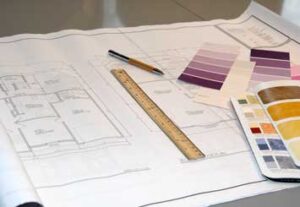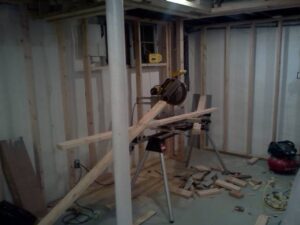Undertaking an interior design and remodeling project can be at once exciting and stressful. The vision you have of a new interior environment cannot be achieved without a significant disruption of your day-to-day routine. There will be dust. This can be stressful.
The best way to ensure that your interior design project runs smoothly is to develop an interior design and remodeling plan well before the first hammer swings. Here are three primary steps for creating an interior design and remodeling plan that may help save your sanity.
Step One: Develop a Design Concept
Develop a design concept that recognizes the full potential of your home and allows the maximum use of your space, creating a perfect sanctuary that provides you the comfort, convenience and the touch of class you desire.
It Starts with an Idea

Most complex projects begin with an idea, usually no more than intuitive hunch, a starting point for further investigation. An idea can come from anywhere, of course — a childhood memory, an object we posses, a random passing thought. Next, evaluate your idea against the constraints of your living space or spaces. What are the sizes and orientations of your existing areas. What are their constraints? Do they still still work with your idea? Comparing your idea against the realities and requirements of your space ensures you don’t force an inappropriate concept for your interior design project.
Scaled Drawings

Scaled drawings are a crucial element in preparing your design concept as they allow aesthetic fine-tuning of proportion. Scaled drawings allow the interaction of new and existing elements to be accurately plotted in two dimensions, enabling the initial idea to be reconciled with the nature of the existing space. Scaled drawings can be done by hand or on computer with a drafting program but they should be prepared as they help you avoid having your design look over themed instead of tasteful and interesting.
Step Two: Determine Your Sequencing
 Your interior design and remodeling project can be an exciting process. However, this process can be quite frustrating if you don’t know the sequence of your various elements. Construction trades rely on proper sequencing in order to keep the costs down and prevent the need to redo work. Without proper sequencing, you might miss out on critical installation opportunities.
Your interior design and remodeling project can be an exciting process. However, this process can be quite frustrating if you don’t know the sequence of your various elements. Construction trades rely on proper sequencing in order to keep the costs down and prevent the need to redo work. Without proper sequencing, you might miss out on critical installation opportunities.
For instance, deciding to change your kitchen cabinets after your drywall has been installed can be very costly. What’s more, if your budget doesn’t allow for such an occurrence, you may not be able to afford such a change and will need to do without. If this happens, every day you use your new kitchen, the annoying reminder of this omission will last long after the dust and disruption have faded. A good contractor will likely know to ask these kinds of questions but more often than not, they will be focused on staying on schedule and keeping their subcontractors on the job.
The design concept that you developed previously will serve as the guide for your sequencing plan. Address your project one room at a time and then fold each one into a plan that spans the entire scope of your project. Proper sequencing of your project will ensure it proceeds smoothly and will save you money in the long run.
Step Three: Develop Your Budget
 Determining an accurate budget is an extremely important step. Your overall budget will determine the quality of materials to be used, finish types and other design details unique to your environment. Many people finance an interior design and remodeling project by taking out a loan or by refinancing their home, so they will already know their overall budget amount. The next step is to distribute it among the various elements of your design concept.
Determining an accurate budget is an extremely important step. Your overall budget will determine the quality of materials to be used, finish types and other design details unique to your environment. Many people finance an interior design and remodeling project by taking out a loan or by refinancing their home, so they will already know their overall budget amount. The next step is to distribute it among the various elements of your design concept.
Create a Check list
 A check list can help you make sure you have accounted for all your decorative needs. The task here is to capture as many aspects of your project as possible. Once you’ve created your list, you can review each item and add or remove items based on your overall budgetary constraints.
A check list can help you make sure you have accounted for all your decorative needs. The task here is to capture as many aspects of your project as possible. Once you’ve created your list, you can review each item and add or remove items based on your overall budgetary constraints.
Cost vs Value
When creating your check list, be careful you don’t substitute “cost” for “value.” A pennywise consumer may limit their options to only the “big box” stores, thinking they offer the best pricing available. While prices may be low at these places, they often do not offer the best value. Big box retailers deal primarily in volume and cannot provide the same level of service and guarantees that a professional designer can, so if a problem arises, they often cannot respond to it in the manner a paying customer would expect.
Many of my clients come to me in the middle of their project in crisis mode because they first went the big-box route, have run into a problem, and cost overruns are threatening their overall budget.
Too many times, this lesson is not learned until late in the project. Many of my clients come to me in the middle of their project in crisis mode because they first went the big-box route, have run into a problem, and cost overruns are threatening their overall budget. The right interior designer can purchase directly from manufacturers so they can be just as completive as the large consumer retailers, and the best ones will offer a wider array of custom choices. The right interior designer can provide you and your design project with a much better value than the big box stores, which will also lower your cost in the long run.
Hire an Interior Designer
There are many reasons why you need an interior designer for your interior design and remodeling project. An interior designer can help you save money through their design experience and their planning ability. An interior designer provides value through quality products, customer service, creativity, and a solid understanding of your goals and values. Remember, VALUE is much more than a product’s cost.

